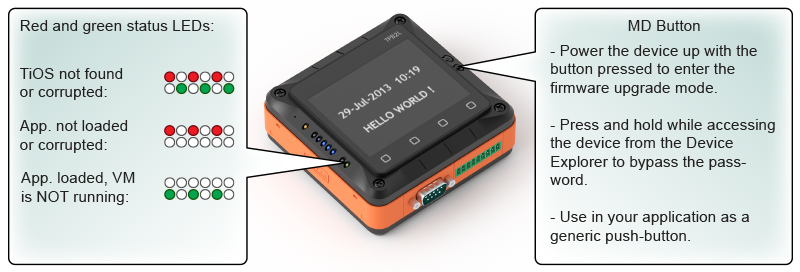Status LEDs and MD Button

Tibbo OS (TiOS) devices rely on a single pushbutton and a pair of red and green status LEDs for basic control and status indication. The pushbutton is often referred to as the "MD," "M," or "setup" button.
Tibbo Project System (TPS) devices, programmable serial controllers, and boards all have the LEDs and the MD button onboard.
Programmable modules, such as the EM1000, provide I/O lines for connecting the LEDs and the button externally. Every good design incorporating a Tibbo module should feature the status LEDs and the MD button on the product's host board. Some modules, such as the EM1206+RJ203 combination, have onboard LEDs and provide I/O lines to wire external LEDs.
Status LEDs
Status LEDs are convenient for judging the current state of a device.
The graphic above presents the three important patterns that you might see when the VM is not executing your application. These patterns are "fast-blinking" — almost at the limit of the human eye's ability to discern them.
When the VM is executing your application, the status LEDs are under the control of the pat. object, meaning that your application can also use the LEDs for its own needs.
These LEDs play a different set of patterns when the device is booted into the Monitor/Loader.
The MD Button
This button serves three purposes:
- To get you into the Monitor/Loader (M/L)
The M/L is a resident firmware that is always present on all Tibbo devices. The M/L allows you to upload TiOS firmware (possibly with a Tibbo BASIC/C application attached) into your device.
Such uploads are normally conducted from within TiOS, but this becomes impossible if you accidentally brick your device; for example, by uploading the wrong firmware. In such a case, the only way to "unbrick" the device is by using the M/L's firmware upgrade function. To enter the firmware upgrade mode, hold the MD button while you power on the device.
For more information, please refer to Monitor/Loader. - To bypass a password
Tibbo devices can be password-protected.
If you don't remember the device's password, performing a device-related action in Device Explorer while holding the MD button pressed will bypass the password.
For example, keeping the MD button pressed and clicking on Set Password will clear the password and let you set a new one. If you don't press the MD button, you will be required to enter the old password first. - As a generic button
The button. object gives your applications access to the MD button. This can be very useful, as there is almost always the need to use a button for something.
